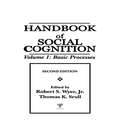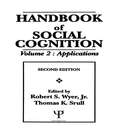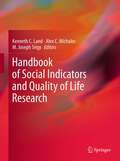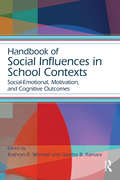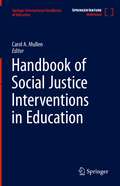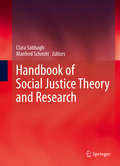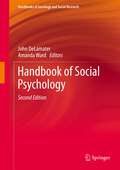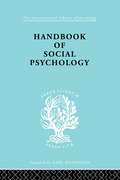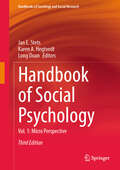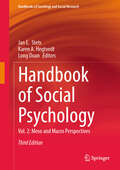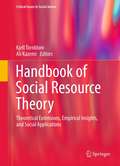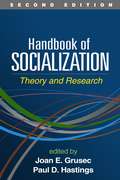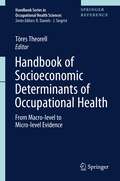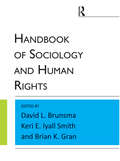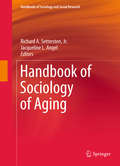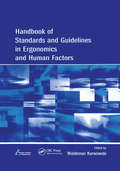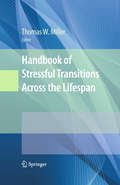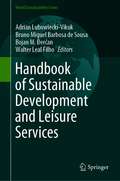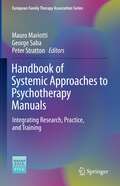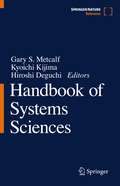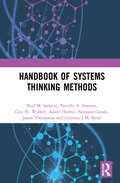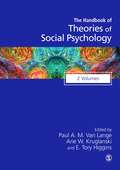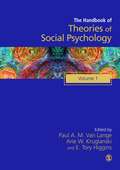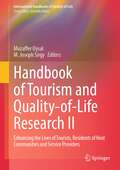- Table View
- List View
Handbook of Social Cognition: Volume 1: Basic Processes
by Robert S. Wyer Thomas K. SrullThis edition of the Handbook follows the first edition by 10 years. The earlier edition was a promissory note, presaging the directions in which the then-emerging field of social cognition was likely to move. The field was then in its infancy and the areas of research and theory that came to dominate the field during the next decade were only beginning to surface. The concepts and methods used had frequently been borrowed from cognitive psychology and had been applied to phenomena in a very limited number of areas. Nevertheless, social cognition promised to develop rapidly into an important area of psychological inquiry that would ultimately have an impact on not only several areas of psychology but other fields as well. The promises made by the earlier edition have generally been fulfilled. Since its publication, social cognition has become one of the most active areas of research in the entire field of psychology; its influence has extended to health and clinical psychology, and personality, as well as to political science, organizational behavior, and marketing and consumer behavior. The impact of social cognition theory and research within a very short period of time is incontrovertible. The present volumes provide a comprehensive and detailed review of the theoretical and empirical work that has been performed during these years, and of its implications for information processing in a wide variety of domains. The handbook is divided into two volumes. The first provides an overview of basic research and theory in social information processing, covering the automatic and controlled processing of information and its implications for how information is encoded and stored in memory, the mental representation of persons -- including oneself -- and events, the role of procedural knowledge in information processing, inference processes, and response processes. Special attention is given to the cognitive determinants and consequences of affect and emotion. The second book provides detailed discussions of the role of information processing in specific areas such as stereotyping; communication and persuasion; political judgment; close relationships; organizational, clinical and health psychology; and consumer behavior. The contributors are theorists and researchers who have themselves carried out important studies in the areas to which their chapters pertain. In combination, the contents of this two-volume set provide a sophisticated and in-depth treatment of both theory and research in this major area of psychological inquiry and the directions in which it is likely to proceed in the future.
Handbook of Social Cognition: Volume 2: Applications
by Robert S. Wyer Thomas K. SrullThis edition of the Handbook follows the first edition by 10 years. The earlier edition was a promissory note, presaging the directions in which the then-emerging field of social cognition was likely to move. The field was then in its infancy and the areas of research and theory that came to dominate the field during the next decade were only beginning to surface. The concepts and methods used had frequently been borrowed from cognitive psychology and had been applied to phenomena in a very limited number of areas. Nevertheless, social cognition promised to develop rapidly into an important area of psychological inquiry that would ultimately have an impact on not only several areas of psychology but other fields as well. The promises made by the earlier edition have generally been fulfilled. Since its publication, social cognition has become one of the most active areas of research in the entire field of psychology; its influence has extended to health and clinical psychology, and personality, as well as to political science, organizational behavior, and marketing and consumer behavior. The impact of social cognition theory and research within a very short period of time is incontrovertible. The present volumes provide a comprehensive and detailed review of the theoretical and empirical work that has been performed during these years, and of its implications for information processing in a wide variety of domains. The handbook is divided into two volumes. The first provides an overview of basic research and theory in social information processing, covering the automatic and controlled processing of information and its implications for how information is encoded and stored in memory, the mental representation of persons -- including oneself -- and events, the role of procedural knowledge in information processing, inference processes, and response processes. Special attention is given to the cognitive determinants and consequences of affect and emotion. The second book provides detailed discussions of the role of information processing in specific areas such as stereotyping; communication and persuasion; political judgment; close relationships; organizational, clinical and health psychology; and consumer behavior. The contributors are theorists and researchers who have themselves carried out important studies in the areas to which their chapters pertain. In combination, the contents of this two-volume set provide a sophisticated and in-depth treatment of both theory and research in this major area of psychological inquiry and the directions in which it is likely to proceed in the future.
Handbook of Social Indicators and Quality of Life Research
by Alex C. Michalos M. Joseph Sirgy Kenneth C. LandThe aim of the Handbook of Social Indicators and Quality of Life Research is to create an overview of the field of Quality of Life (QOL) studies in the early years of the 21st century that can be updated and improved upon as the field evolves and the century unfolds. Social indicators are statistical time series "...used to monitor the social system, helping to identify changes and to guide intervention to alter the course of social change". Examples include unemployment rates, crime rates, estimates of life expectancy, health status indices, school enrollment rates, average achievement scores, election voting rates, and measures of subjective well-being such as satisfaction with life-as-a-whole and with specific domains or aspects of life. This book provides a review of the historical development of the field including the history of QOL in medicine and mental health as well as the research related to quality-of-work-life (QWL) programs. It discusses several of QOL main concepts: happiness, positive psychology, and subjective wellbeing. Relations between spirituality and religiousness and QOL are examined as are the effects of educational attainment on QOL and marketing, and the associations with economic growth. The book goes on to investigate methodological approaches and issues that should be considered in measuring and analysing quality of life from a quantitative perspective. The final chapters are dedicated to research on elements of QOL in a broad range of countries and populations.
Handbook of Social Influences in School Contexts: Social-Emotional, Motivation, and Cognitive Outcomes (Educational Psychology Handbook)
by Kathryn R. Wentzel Geetha B. RamaniThe Handbook of Social Influences in School Contexts draws from a growing body of research on how and why various aspects of social relationships and contexts contribute to children’s social and academic functioning within school settings. Comprised of the latest studies in developmental and educational psychology, this comprehensive volume is perfect for researchers and students of Educational Psychology. Beginning with the theoretical perspectives that guide research on social influences, this book presents foundational research before moving on to chapters on peer influence and teacher influence. Next, the book addresses ways in which the school context can influence school-related outcomes (including peer and teacher-student relationships) with specific attention to research in motivation and cognition. Within the chapters authors not only present current research but also explore best-practices, drawing in examples from the classroom. With chapters from leading experts in the field, The Handbook of Social Influences in School Contexts provides the first complete resource on this topic.
Handbook of Social Justice Interventions in Education (Springer International Handbooks of Education)
by Carol A. MullenThe Handbook of Social Justice Interventions in Education features interventions in social justice within education and leadership, from early years to higher education and in mainstream and alternative, formal and informal settings. Researchers from across academic disciplines and different countries describe implementable social justice work underway in learning environments—organizations, programs, classrooms, communities, etc. Robust, dynamic, and emergent theory-informed applications in real-world places make known the applied knowledge base in social justice, and its empirical, ideological, and advocacy orientations.A multiplicity of social justice-oriented lenses, policies, strategies, and tools is represented in this Handbook, along with qualitative and quantitative methodologies. Alternative and conventional approaches alike advance knowledge and educational and social utility. To cover the field comprehensively the subject (i.e., social justice education and leadership) is subdivided into four sections. Part 1 (background) provides a general background of current social justice literature. Part II (schools) addresses interventions and explorations in preK-12 schools. Part III (education) covers undergraduate and graduate education and preservice teacher programs, classrooms, and curricula, in addition to teacher and student leadership in schools. Part IV (leadership) features educational leadership and higher education leadership domains, from organizational change efforts to preservice leader preparation programs, classrooms, etc. Part V (comparative) offers interventions and explorations of societies, cultures, and nations.Assembling this unique material in one place by a leading cast will enable readers easy access to the latest research-informed interventionist practices on a timely topic. They can build on this work that takes the promise of social justice to the next level for changing global learning environments and workplaces.
Handbook of Social Justice Theory and Research
by Clara Sabbagh Manfred SchmittThe International Society for Justice Research (ISJR) aims to provide a platform for interdisciplinary justice scholars who are encouraged to present and exchange their ideas. This exchange has yielded a fruitful advance of theoretical and empirically-oriented justice research. This volume substantiates this academic legacy and the research prospects of the ISJR in the field of justice theory and research. Included are themes and topics such as the theory of the justice motive, the mapping of the multifaceted forms of justice (distributive, procedural) and justice in context-bound spheres (e. g. non-humans). It presents a comprehensive "state of the art" overview in the field of justice research theory and it puts forth an agenda for future interdisciplinary and international justice research. It is worth noting that authors in this proposed volume represent ISJR's leading scholarship. Thus, the compilation of their research within a single framework exposes potential readers to high quality academic work that embodies the past, current and future trends of justice research.
Handbook of Social Psychology
by John Delamater Amanda WardThis handbook provides a broad overview of the field of social psychology and up-to-date coverage of current social psychological topics. It reflects the recent and substantial development of the field, both with regard to theory and empirical research. It starts out by covering major theoretical perspectives, including the interactionist, identity, social exchange, social structure and the person perspectives. Next, it discusses development and socialization in childhood, adolescence and adulthood. In addition to updated discussions of topics that were included in the first edition, the part examining personal processes includes entirely new topics, such as social psychology and the body and individual agency and social motivation. Interpersonal processes are discussed from a contemporary perspective with a focus on stress and health. The final section examines the person in sociocultural context, and includes another topic new to the second edition, the social psychology of race and gender and intersectionality.
Handbook of Social Psychology (International Library of Sociology)
by Kimball YoungFirst Published in 1998. Routledge is an imprint of Taylor & Francis, an informa company.
Handbook of Social Psychology: Vol. 1: Micro Perspective (Handbooks of Sociology and Social Research)
by Jan E. Stets Karen A. Hegtvedt Long DoanThis third edition of the highly successful handbook is presented for the first time in two volumes, covering the field of social psychology more comprehensively than earlier, including applying social psychology to different areas in sociology. It showcases the dynamics of social psychological phenomena across the micro level (Volume 1), and meso and macro levels of social reality (Volume 2). The reader will see how social psychology can be leveraged at the interactive level, within groups and larger units, and across many aspects of society, thus showing the expansiveness of social psychology in understanding social behavior, social organization, and social structures. The emphasis in Volume 1 rests on theoretical frameworks for processes occurring within individuals and among interacting individuals. The chapters span fundamental principles pertaining to the social construction of meaning, identity, emotions, language, and social cognition, and the structure and dynamics unfolding in interactions characterized by status, social exchange, network linkages, and justice. A shorter chapter, offering an empirical illustration, complements each theoretically oriented chapter. Together, the two volumes provide the reader with theoretical tools useful in understanding the basics of individual behavior, while highlighting how social psychological processes emerge in a variety of contexts. The connections among micro, meso, and macro levels, through the lens of social psychology, forge new pathways to understanding the various forms of inequality plaguing the social world.
Handbook of Social Psychology: Vol. 2: Meso and Macro Perspectives (Handbooks of Sociology and Social Research)
by Jan E. Stets Karen A. Hegtvedt Long DoanThis third edition of the highly successful handbook is presented for the first time in two volumes, covering the field of social psychology more comprehensively than earlier, including applying social psychology to different areas in sociology. It showcases the dynamics of social psychological phenomena across the micro level (Volume 1), and meso and macro levels of social reality (Volume 2). The reader will see how social psychology can be leveraged at the interactive level, within groups and larger units, and across many aspects of society, thus showing the expansiveness of social psychology in understanding social behavior, social organization, and social structures. Volume 2 highlights the relevance of social psychological principles and processes to social categories, groups, and organizations at the meso level, and to institutions and inequality that reflect social life at the macro level. Chapters pertaining to the meso level analyze individuals&’ memberships in social categories such as gender, race, class, age, and sexuality. Additionally, meso-level concerns spotlight the context of work and organizations. Chapters at the macro level consider social psychologically oriented work in such institutions as the family, education, and religion and examine other areas such as crime and deviance, the media, immigration, and health. Together, the two volumes provide the reader with theoretical tools useful in understanding the basics of individual behavior while highlighting how social psychological processes emerge in a variety of contexts. The connections among micro, meso, and macro levels, through the lens of social psychology, forge new pathways to understanding the various forms of inequality plaguing the social world.
Handbook of Social Resource Theory
by Kjell Törnblom Ali KazemiA "social resource" refers to anything that is transacted between two people. It encompasses both the tangible (such as money and material goods) and the intangible (such as love, respect, information, or services) that are provided or withheld in people's daily lives. The exchange and availability of social resources have a wide range of impacts on everything from health, to quality of life, to social status, to motivation. Understanding Social Resource Theory (SRT) is a key to both Social Psychology (both sociological and psychological), and Public Policy. The framework for the study of SRT is relatively new, beginning with an article by Uriel G. Foa in 1971. Since then, this framework has developed to include new types of social resources and new applications. The Editors of this volume have worked directly with Dr. Foa before his passing, and this volume represents a continuation and development of SRT framework to new applications, including: -Quality of Life -Work Satisfaction -Interpersonal Relationships -Cognitive Development -Consumer Behavior -Cross-Cultural Behavior Contributions to Handbook of Social Resource Theory also integrate SRT with other prevailing Sociological frameworks, including: distributive and procedural justice, social comparison theory, and development of social relationships. SRT has already established a link between social psychology and economics, and this link is explored even further. With clear applications to many fields of study, including Sociology, Social Psychology, Public Policy, and Quality of Life research, this interdisciplinary volume is a clear, systematic, and comprehensive approach to understanding Social Resource Theory, its range of applications, and the future directions of research.
Handbook of Socialization, Second Edition
by Joan E. Grusec Paul D. HastingsThis highly regarded handbook remains the leading reference and advanced text on socialization. Bringing together foremost authorities, the volume reviews the breadth of current knowledge on socialization processes across the lifespan. Contributors present cutting-edge theories and findings pertaining to family, peer, school, community, media, and other influences on individual development. Genetics and biology, cultural psychology, and affective science are given particular attention. Three themes guide the book: the interdependence of biology and experience, the bidirectionality of socialization processes, and the many contributing factors that interact to produce multiple socialization processes and pathways. New to This Edition *Revised structure reflects the diversity of socializing relationships in multiple contexts across the lifespan. *Chapters on adolescence, socialization in the workplace, moral development, culture, and neuroscience. *Many new authors and extensively revised chapters.
Handbook of Socioeconomic Determinants of Occupational Health: From Macro-level to Micro-level Evidence (Handbook Series in Occupational Health Sciences)
by Töres TheorellThis anthology provides readers of scientific literature on socioeconomic factors and working conditions with the newest knowledge in this field. Since our world is subjected to constant change in accelerating speed, scientific reviews and updates are needed. Fortunately, research methodology in epidemiology, physiology, psychology and sociology is also developing rapidly and therefore the scientific community can provide politicians and policy makers with increasingly sophisticated and exact descriptions of societal factors in relation to work. The anthology starts in the macro level sphere – with international perspectives and reviews related to working conditions in relation to political change (the fall of the Soviet Union) gender, age, precarious employment, national economy and retirement. Two chapters relate to national policies and activities in international organizations. The second part of the book relates to the meso level sphere – with reviews on social patterns in distributions of psychosocial and physical risks at work in general as well as reviews on noise, shift work, under/overemployment, occupational physical activity, job intensity (which may be a particularly important problem in low income countries), digitization in modern work, climate change, childhood determinants of occupational health in adult years and theoretical models currently used in occupational epidemiology - demand/control, effort/reward, organizational justice, psychosocial safety climate, conflicts, bullying/harassment. This part of the book ends with two chapters on interventions (one chapter on the use of cultural interventions and one on interventions and their evaluation in general) and two chapters on financial aspects of poor/good work environments and evaluations of interventions. In the third part of the book the micro level is addressed. Here mechanisms translating working conditions into physiology are discussed. This starts in general theory relating basic theories regarding energy storage and release to psychosocial theory (extension of demand control theory). It also includes regeneration physiology, autonomic nervous system function, immunology and adverse behaviour.Sections in the Handbook: Macro-level determinants of occupational health: Akizumi Tsutsumi, Meso-level determinants of occupational health: Morten Wahrendorf and Jian Li, Micro-level determinants of occupational health: Bradley J. Wright
Handbook of Sociology and Human Rights
by Keri E. Iyall Smith David L. Brunsma Brian K GranLong the province of international law, human rights now enjoys a renaissance of studies and new perspectives from the social sciences. This landmark book is the first to synthesize and comprehensively evaluate this body of work. It fosters an interdisciplinary, international, and critical engagement both in the social study of human rights and the establishment of a human rights approach throughout the field of sociology. Sociological perspectives bring new questions to the interdisciplinary study of human rights, as amply illustrated in this book. The Handbook is indispensable to any interdisciplinary collection on human rights or on sociology. This text: Brings new perspectives to the study of human rights in an interdisciplinary fashion. Offers state-of-the-art summaries, critical discussions of established human rights paradigms, and a host of new insights and further research directions. Fosters a comprehensive human rights approach to sociology, topically representing all 45 sections of the American Sociological Association.
Handbook of Sociology of Aging
by Jacqueline L. Angel Richard A. Settersten Jr.The Handbook of Sociology of Aging is the most comprehensive, engaging, and up-to-date treatment of developments within the field over the past 30 years. The volume represents an indispensable source of the freshest and highest standard scholarship for scholars, policy makers, and aging professionals alike. The Handbook of Sociology of Aging contains 45 far-reaching chapters, authored by nearly 80 of the most renowned experts, on the most pressing topics related to aging today. With its recurring attention to the social forces that shape human aging, and the social consequences and policy implications of it, the contents will be of interest to everyone who cares about what aging means for individuals, families, and societies. The chapters of the Handbook of Sociology of Aging illustrate the field's extraordinary breadth and depth, which has never before been represented in a single volume. Its contributions address topics that range from foundational matters, such as classic and contemporary theories and methods, to topics of longstanding and emergent interest, such as social diversity and inequalities, social relationships, social institutions, economies and governments, social vulnerabilities, public health, and care arrangements. The volume closes with a set of personal essays by senior scholars who share their experiences and hopes for the field, and an essay by the editors that provides a roadmap for the decade ahead. The Handbook of Sociology of Aging showcases the very best that sociology has to offer the study of human aging.
Handbook of Standards and Guidelines in Ergonomics and Human Factors
by Waldema KarwowskiA comprehensive review of international and national standards and guidelines, this handbook consists of 32 chapters divided into nine sections that cover standardization efforts, anthropometry and working postures, designing manual material, human-computer interaction, occupational health and safety, legal protection, military human factor standar
Handbook of Stressful Transitions Across the Lifespan
by Thomas W. MillerThe modern life cycle is characterized by stressful transitions, when unexpected events--and even many expected ones--challenge people's functioning, health, and sense of self-worth. The international, multidisciplinary perspectives provided in the Handbook of Stressful Transitions Across the Lifespan cover these periods as they occur through youth, adulthood, and aging, bringing together theoretical and clinical findings, case studies, and literature reviews in one authoritative volume. A diverse panel of clinicians, researchers, and educators focuses on the psychological, biological, cultural and spiritual factors surrounding not only trauma and loss but also coping and growth, risk and mitigating factors, and promising interventions. Whether topics are just beginning to receive in-depth attention (the first job; becoming adoptive parents), ongoing issues requiring new insights (veterans' adjustment to civilian life; chronic illness), or emerging concepts (trauma growth; animal-assisted therapy), coverage is well-written, engaging, and eminently useful. A sampling of the topics featured in the Handbook: The developmental neurobiology of stress. The long-term effects of divorce on children. Self-regulation across life transitions. Money in (E)motion: stressful financial transitions. The influence of food on adapting to life stressors. The transition to retirement as a stressful event. With its comprehensive scope and wealth of data, the Handbook of Stressful Transitions Across the Lifespan will appeal to a variety of professional readers, including researchers and scholars in the fields of social, developmental and clinical psychology, sociology, and public health.
Handbook of Sustainable Development and Leisure Services (World Sustainability Series)
by Walter Leal Filho Adrian Lubowiecki-Vikuk Bruno Miguel Barbosa de Sousa Bojan M. ĐerčanThis book reviews empirical and theoretical research on sustainable development in the context of leisure management for communities. Although leading research centers are pursuing interdisciplinary research on leisure in the context of sustainable development, there are still few papers that holistically address the current challenges in this area. In addition, demographic changes have made the promotion of a healthy lifestyle essential. Doing so requires responsible behavior on the part of various stakeholders in this market.This book fills an important gap in the literature and gathers contributions from an interdisciplinary and international team of authors, whose fields of expertise include human geography, management, intersections of sustainability and leisure, behavioral psychology and tourism.
Handbook of Systemic Approaches to Psychotherapy Manuals: Integrating Research, Practice, and Training (European Family Therapy Association Series)
by Peter Stratton George Saba Mauro MariottiThis handbook examines the development and use of manuals to guide and support systemic couples and family therapies. It addresses the process of manualizing, providing a secure base for therapist creativity rather than delineating prescriptive procedures. The volume addresses therapist and trainer concerns by demonstrating the value of sufficiently articulating clinical and teaching models to inform colleagues of what actually occurs during therapy. The book describes the history, value, and controversies of manuals. In addition, it explores issues and experiences in the creation of manuals, identifies research issues related to the use and evaluation of manuals, and addresses training as a context for the application of treatment manuals.Key areas of coverage include:Reports of experiences with major, internationally established manuals, formulations of innovative practices by their developers, and specifications of training programs.Discussion of the various formats of manuals, demonstrating their benefit and transportability across different contexts.Surveys of a broad selection of manuals, creating a flexible and diversified concept of what forms manuals may take.Essential guidance for using manuals, which is an indispensable step for the field to progress and to claim to health resource commissioning, governments and insurance agencies that the systemic practice is evidence based and effective.The Handbook of Systemic Approaches to Psychotherapy Manuals is an essential resource for researchers, professors, and graduate students as well as clinicians and related therapists and professionals in clinical psychology, family studies, public health, social work, psychotherapy, child and adolescent psychology and all interrelated disciplines.
Handbook of Systems Sciences
by Kyoichi Kijima Gary S. Metcalf Hiroshi DeguchiThe primary purpose of this handbook is to clearly describe the current state of theories of systems sciences and to support their use and practice. There are many ways in which systems sciences can be described. This handbook takes a multifaceted view of systems sciences and describes them in terms of a relatively large number of dimensions, from natural and engineering science to social science and systems management perspectives. It is not the authors’ intent, however, to produce a catalog of systems science concepts, methodologies, tools, or products. Instead, the focus is on the structural network of a variety of topics. Special emphasis is given to a cyclic–interrelated view; for example, when a theory of systems sciences is described, there is also discussion of how and why the theory is relevant to modeling or practice in reality. Such an interrelationship between theory and practice is also illustrated when an applied research field in systems sciences is explained. The chapters in the handbook present definitive discussions of systems sciences from a wide array of perspectives. The needs of practitioners in industry and government as well as students aspiring to careers in systems sciences provide the motivation for the majority of the chapters. The handbook begins with a comprehensive introduction to the coverage that follows. It provides not only an introduction to systems sciences but also a brief overview and integration of the succeeding chapters in terms of a knowledge map. The introduction is intended to be used as a field guide that indicates why, when, and how to use the materials or topics contained in the handbook.
Handbook of Systems Thinking Methods
by Jason Thompson Neville A. Stanton Guy H. Walker Paul M. Salmon Natassia Goode Adam Hulme Gemma J.M. ReadThe systems thinking philosophy has become popular in human factors and ergonomics and safety science. These methods are being used to understand and resolve complex societal problems in areas such as transport safety, workplace safety, medication error, disaster management, child abuse, financial crises, terrorism, climate change and public health and wellbeing. This handbook presents practical step-by-step guidance for practitioners and researchers wishing to use these methods to tackle complex problems. Each method includes an example case study which demonstrates how the method can be applied and how the results can be interpreted and translated into practical recommendations. The book presents practical guidance on state-of-the-art systems thinking methods and offers case study applications describing systems thinking methods in novel areas. It explains how to translate the outputs of systems thinking methods in practice and introduces systems thinking with an overview of Human Factors and Ergonomics applications. This book will serve as a great reference for students and engineers in the field of systems engineering, complex systems and the design and development of systems, including ergonomics/human factors and systems engineers, designers, architects, industrial engineers, project management engineers, reliability engineers, risk engineers, software engineers and computer engineers.
Handbook of Teaching and Learning Persian as a Second Language (Springer Handbooks in Languages and Linguistics)
by Hooman SaeliThis collection explores relevant pedagogical and sociolinguistic topics in the teaching and learning of Persian as a foreign and second language. Owing to the dearth of research in many areas pertaining to the teaching and learning of Persian, this handbook provides empirically-supported insights into various aspects of these areas. While the literature on teaching and learning Persian is growing, the field lacks a cohesive collection on Persian as a foreign/second language. The book addresses issues pertaining to the standardization and validation of teaching and assessment methods, which remain under-explored in the contexts of teaching and learning Persian. It also covers the teaching of Persian pragmatics, the use of corpora, as well as a range of different areas within linguistics, including phonetics, prosody, and historical linguistics. This comprehensive collection contributes substantially to the scientific study of many aspects of teaching and learning Persian which have been neglected for decades. A must-have text in Persian language pedagogy and Persian sociolinguistics, it an essential book for those in teaching and learning in Persian language programs worldwide.
Handbook of Theories of Social Psychology: Collection: Volumes 1 & 2 (SAGE Social Psychology Program)
by Arie W. Kruglanski Dr E Tory Higgins Paul A. Van LangeProviding a comprehensive exploration of the major developments of social psychological theories that have taken place over the past half century, this innovative two-volume handbook is a state of the art overview of the primary theories and models that have been developed in this vast and fascinating field. Authored by leading international experts, each chapter represents a personal and historical narrative of the theory's development including the inspirations, critical junctures, and problem-solving efforts that effected theoretical choices and determined the theory's impact and its evolution. Unique to this handbook, these narratives provide a rich background for understanding how theories are created, nurtured, and shaped over time, and examining their unique contribution to the field as a whole. To examine its societal impact, each theory is evaluated in terms of its applicability to better understanding and solving critical social issues and problems.
Handbook of Theories of Social Psychology: Volume One (SAGE Social Psychology Program)
by Arie W. Kruglanski Dr E Tory Higgins Paul A. Van LangeThis innovative two-volume handbook provides a comprehensive exploration of the major developments of social psychological theories that have taken place over the past half century, culminating in a state of the art overview of the primary theories and models that have been developed in this vast and fascinating field. Authored by leading international experts, each chapter represents a personal and historical narrative of the theory's development including the inspirations, critical junctures, and problem-solving efforts that have effected the choices made in each theory's evolution as well as the impact each has had on the canon of social psychology. Unique to this handbook, these narratives provide a rich background for understanding how theories are created more generally; how they're nurtured and shaped over time: and how through examination we can better understand their unique contribution to society as a whole. The Handbook also illustrates how the various theories contribute to understanding and solving critical social issues and problems. The Handbook of Theories of Social Psychology is an essential resource for researchers and students of social psychology and related disciplines.
Handbook of Tourism and Quality-of-Life Research II: Enhancing the Lives of Tourists, Residents of Host Communities and Service Providers (International Handbooks of Quality-of-Life)
by Muzaffer Uysal M. Joseph SirgyThe second volume of this handbook develops on and extends the discussion in the successful first volume, published in 2012. This is a timely addition to the literature, drawing on the momentum that quality of life (QOL) research in tourism has gained in the 21st century and on the boom in the tourism industry itself. It focuses on four areas of growth in QOL research in the recent past: (1) travelers/tourists, (2) host communities, (3) service providers, and (4) the role of technology. The handbook helps management of tourism firms and policy makers develop specific policies and programs to ensure the most positive impact of tourism on tourists, host communities, and service providers. The comprehensive coverage of topics in this handbook makes it a state-of-the-art reference. Academics interested in QOL research in travel and tourism, tourism practitioners interested in applying the science of QOL in the tourism industry, as well as policy makers involved in regulating the industry will view the handbook as indispensable source of recent research.
